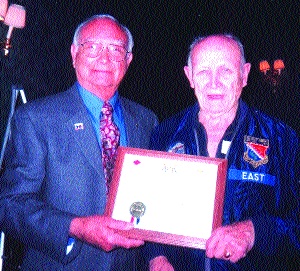By Fred “Crash” Blechman

Twenty-eight members pose at a recent monthly dinner meeting of the Two-Block Fox Squadron of the Association of Naval Aviation at the Odyssey Restaurant.
A former three-war fighter pilot who made it into the Guinness World Book of Records was the guest speaker at the late-February monthly local dinner meeting of the Association of Naval Aviation. It was also “Flight Jacket Night.”
The luxurious Odyssey Restaurant sits at the edge of a mountain several hundred feet above the north end of the San Fernando Valley. Large windows from the various meeting and banquet rooms look south and east for a spectacular view of the Valley, especially at night. It is in these surroundings that the San Fernando Valley Chapter of the ANA, dubbed “The Two-Block Fox Squadron,” meets on the third Thursday of each month. Members and guests come not only from the Navy, but also the Marine Corps, Air Force, Coast Guard, Police, Civil Air Patrol and anyone interested in aviation as a key element of our national defense posture.
Once a year, members and guests are encouraged to come in uniform or flight jackets, and this was the night. The guest speaker was Lieutenant Colonel Clyde B. East, USAF, 81, who retired from the service in 1965 after serving in WWII, Korea and Vietnam. East flew hundreds of combat missions in various reconnaissance fighter aircraft, earning the Air Medal with 42 Oak Leaf Clusters (36 in WWII, 6 in Korea), qualifying him to be entered into the first Guinness World Book of Records for the most Air Medal with Clusters.
East became a double-ace when he was credited with destroying 14-1/2 enemy aircraft in air combat while flying almost 300 missions in the fully-armed RF-51 photo Mustang during WWII in Europe. He also flew over 100 missions in the RF-80 Shooting Star over Korea from 1950-1952. Before Vietnam, where he was involved with air operations before his retirement, he flew two reconnaissance missions in the RF-101 Voodoo over Cuba during the Cuban missile crisis in October 1962.
The United States learned from aerial reconnaissance flights like East’s that the Soviet Union had secretly installed missiles in Cuba, about 90 miles from Florida. The missiles could have been used to launch nuclear attacks on American cities. The crisis was one of the most serious incidents of the Cold War, a period of intense U.S.-Soviet rivalry that had begun after World War II had ended in 1945. Most experts believe that the missile crisis brought the United States and the Soviet Union to the brink of nuclear war.

Commanding Officer Pete Prieto (left) awards a certificate of appreciation to Lt. Col. Clyde East, double fighter ace, after his 63-slide presentation of experiences in three wars.
East first became interested in airplanes when he was 6 years old, but did not get his first flight until he went up with a barnstormer in Chatham, Va., when he was 15. In 1941, because he was too young to join the U.S. Army Air Corps, he left his family’s tobacco farm in central Virginia and joined the Royal Canadian Air Force, where he had his first training flight, in a Fleet Finch, two weeks before the Japanese attacked Pearl Harbor. Switching to the Tiger Moth, and then the North American Harvard, East received his RCAF wings in November of 1942, and was immediately sent to England for operational training. He joined the 414th Squadron, which was equipped with the Allison-powered RF-51 Mustang.
“It was the best airplane in England at that time—so long as you stayed below 6,000 feet,” says East. It had two 50-caliber machine guns in the nose, two more in the wings, plus four 30-caliber machine guns in the wings, plus the photo equipment.
After about 60 combat missions with the RCAF, East transferred in 1944 to the U.S. 9th Air Force, where he first flew Spitfires.
“For the pure pleasure of flying, my favorite plane was the Spitfire,” East related. “I never operated a plane that was smoother or easier, that guys loved to fly more, than the Spitfire.”
Soon the squadron received Rolls-Royce Merlin-powered RF-51s that could fight at 30,000 feet as well as do low-level photoreconnaissance and strafing. As East narrated 63 slides in his presentation, he said at one point, referring to his hundreds of combat missions, “I believe I’m the luckiest guy in the world. I only had one bullet hole in one airplane over Germany when a guy got on my tail.”
After retiring from the Air Force in 1965, East worked for the RAND Corporation doing military studies until final retirement in 1994. He named his airplanes “Li’l Margaret” after his wife of almost 58 years (she died last year). The couple had six children (four still living). East has eight grandchildren and three great-grandchildren.
For more information about the ANA San Fernando Valley Squadron, contact Pete Prieto, squadron commander, at (805) 582-2928.











